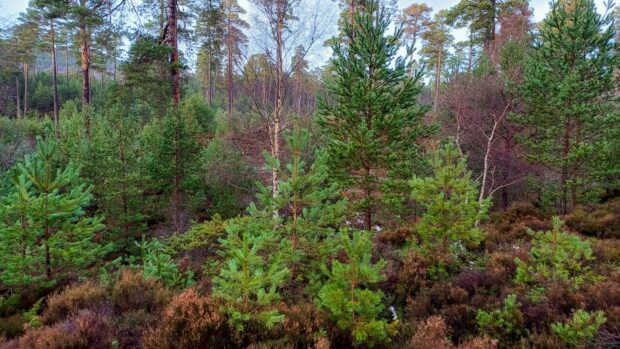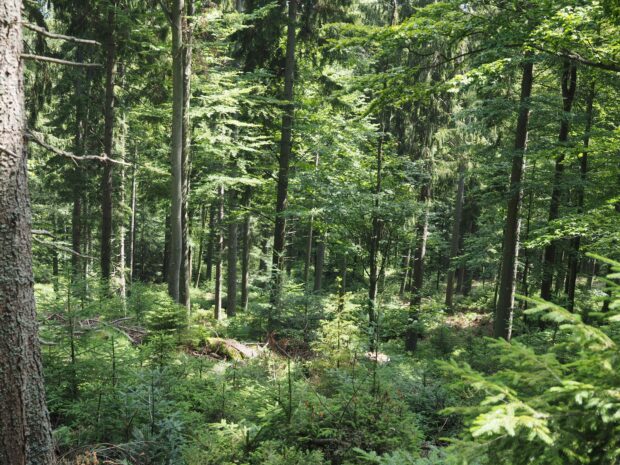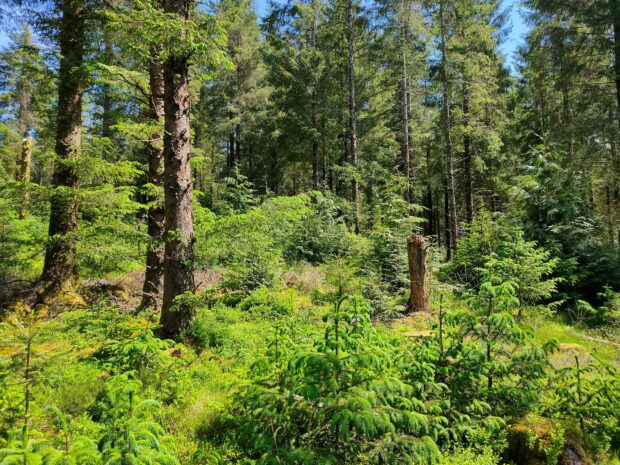 This blog is written in memory of our late chair Bill Mason, who guided the work of the Continuous Cover Forestry Group over the past 10 years, he will be sorely missed. This guest blog is a joint venture written by all members of the Continuous Cover Forestry Group, including Bill.
This blog is written in memory of our late chair Bill Mason, who guided the work of the Continuous Cover Forestry Group over the past 10 years, he will be sorely missed. This guest blog is a joint venture written by all members of the Continuous Cover Forestry Group, including Bill.
The active management of woodlands is widely recognised as being important for the health, well-being and sustainability of our woodlands. Among the most attractive options is an approach called Continuous Cover Forestry (CCF).
This is a form of forestry where the forest canopy is maintained and where the forest is renewed through the creation of small gaps for natural regeneration to become established. The soil is carefully conserved and there is an absence of clear-felling. CCF is therefore a good option where the woodland owner wishes to produce timber, maintain wildlife habitats and enjoy their woodland environment.
Points to consider
If you are considering adopting CCF as means of managing your broadleaf or mixed coniferous woodland, some preconditions need to be met:
- The age of the trees and their management history needs to be properly considered to evaluate the best treatment; windthrow (trees uprooted by wind) can be a significant risk in woodlands where thinning has relapsed and the stability of trees is compromised.
- Previous low thinning operations may have impeded the transformation process from an even aged plantation to an irregular structured mixed species forest, due to the removal of saplings and poles, which are needed to grow into the quality, larger trees of the future.
- Uncontrolled browsing by deer, rabbits and squirrels can severely damage timber and reduce natural regeneration, and without effective and sustained wildlife management, the wider benefits of CCF will not be achieved.
The logistics of harvesting and extracting larger timber from CCF managed forests can be difficult in woodlands without a well-planned network of racks, tracks and roads. This will need to be professionally assessed by a suitably qualified contractor before work can commence on site.

Conditions for CCF
An irregularly structured and/or mixed species forest can be achieved with respacing, regular thinning and selective felling, but this requires patience. It can take many decades to transform a monoculture to a mixed species forest with a variety of field, shrub, and canopy layers, but it is worth persevering as there are so many surprising rewards if you adopt this approach.
The Continuous Cover Forestry Group promotes silvicultural practice (the care and cultivation of woodlands to deliver particular benefits) as a middle-ground solution for reconciling timber production and nature conservation. CCF seeks to minimise the negative impacts of forestry operations on the many ecosystem goods and services a forest provides, such as buffering storm water, preventing soil erosion, providing food and wood fuel, supporting health and wellbeing, the provision of shade and shelter for livestock and even cooling our towns and cities.
All of these services are provided in perpetuity for free, by a functional forest ecosystem, which we know is more resilient to the effects of climate change and pests and diseases.

The rewards of CCF
CCF management is not prone to the boom and bust timber fluctuations typical of even-aged forests managed by clearfelling and restocking. In a CCF managed forest, trees are only harvested when they reach their target diameter or maximum financial value, and this provides flexibility to respond to changing timber markets. By measuring trees and calculating incremental growth across a stand, foresters have a high degree of silvicultural control, enabling them to plan and forecast timber harvests on regular cycles with improved confidence about working under ever-changing environmental conditions.
Much of our native woodland flora and fauna is adapted to thrive in woodlands that are transient in nature, where habitats are inadvertently created or maintained throughout the working forest. CCF requires little and often management interventions such as thinning, which creates areas of bare ground promoting natural regeneration, deadwood niches for saproxylic beetles and cavities for breeding birds, as well as an understory of shrubs and ground flora benefitting fauna such as butterflies and bats.
CCF maintains water, carbon and nutrient cycles of the forest ecosystem, which improves the fertility of the soil and therefore the productivity of timber without the need for expensive tending costs, replanting costs or herbicides.
Seed is only produced from healthy genetically superior trees left to grow to maturity, and through natural regeneration the next cohort of trees are better adapted to their local environment, removing the need for expensive planting or tending costs. Windthrow still occurs sporadically in a CCF managed forest, but this is seen as a natural means of diversifying the structure of the forest, allowing trees to develop deeper crowns and extensive root structures, increasing overall stand stability into the future. Under CCF management, glades of different sizes are created serendipitously by windthrow events, creating habitat for a new assemblage of invertebrates, plants, birds and mammals, as well as a positive opportunity for introducing more light demanding tree species.

CCF managed woodlands are enjoyable places to work in, the effects of silvicultural practice can be seen almost immediately and the role of the forester becomes the role of a scientist, ecologist, economist, hydrologist or statistician. The socio-economic impacts of CCF are evident through the provision of a wide diversity of local, often high quality, products and services provided by chainsaw operators, sawmillers, forest managers, timber-framers, carpenters, wood-fuel buyers, growers, planters, engineers and farmers.
CCF also demonstrates how woodlands and timber can be a means of revitalising the health and prosperity of our local communities, as well as creating woodlands resilient to the effects of a changing climate, increased pests and diseases and fluctuating timber markets.
Read more about the benefits of Continuous Cover Forestry.


